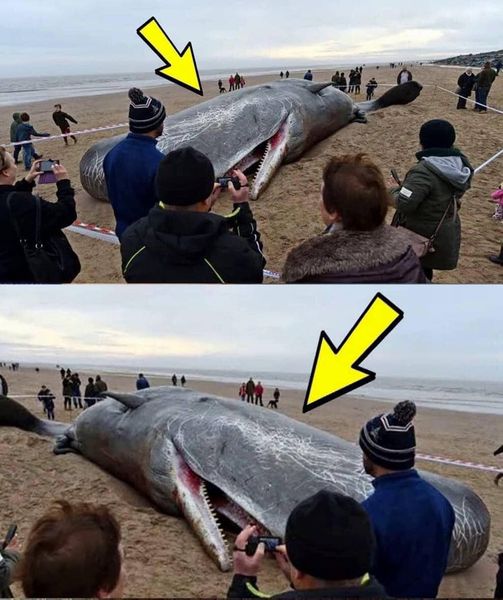In February 2023, the shores of Hawaii bore witness to a grim and shocking discovery that brought global attention to the devastating impact of human activity on marine life. A massive sperm whale, found lifeless and washed ashore, became the subject of intense scientific examination. What researchers uncovered inside its stomach left the world stunned and deeply concerned. This magnificent creature, a symbol of the ocean’s grandeur, had fallen victim to the growing crisis of plastic pollution, a problem that has reached catastrophic levels in our oceans.

Upon conducting a necropsy, scientists found an alarming assortment of plastic debris and fishing nets lodged inside the whale’s stomach. The sheer quantity and variety of man-made waste discovered were both horrifying and heart-wrenching. Items such as tangled fishing nets, plastic bags, and various other fragments of synthetic materials had accumulated within the whale’s digestive system. This collection of waste not only highlighted the pervasive nature of plastic pollution but also underscored the tragic reality faced by countless marine species that unknowingly consume or become entangled in these materials.
The discovery was a stark reminder of the immense threat posed by the millions of tons of plastic that enter the world’s oceans every year. According to researchers, this particular sperm whale likely ingested the plastic while foraging for food. Mistaking the floating debris for prey, the whale consumed materials that its body could not digest, ultimately leading to severe blockages and its untimely death. Tragically, this is not an isolated incident. Marine mammals, seabirds, turtles, and countless other oceanic creatures are falling victim to the same fate, their lives cut short by humanity’s disregard for the environment.
The plight of this sperm whale serves as a grim symbol of a broader environmental crisis. Plastic pollution has become one of the most pressing challenges of our time, with over eight million tons of plastic entering the oceans annually. From microplastics to large discarded items, this waste infiltrates marine ecosystems, disrupting food chains and endangering biodiversity. The materials are not only ingested by marine animals but also break down into microplastics, which are consumed by smaller organisms, eventually making their way up the food chain and even into the seafood consumed by humans.
This tragic incident in Hawaii has reignited calls for urgent action to address the global plastic pollution crisis. Environmentalists, scientists, and policymakers emphasize the need for a multifaceted approach to mitigate the damage. Key strategies include reducing plastic production, improving waste management systems, and promoting the development and use of biodegradable alternatives. Public awareness campaigns have also gained momentum, encouraging individuals to reduce their reliance on single-use plastics, recycle responsibly, and participate in beach clean-up initiatives.
Moreover, governments and international organizations are being urged to enforce stricter regulations on industries that contribute to plastic pollution. Initiatives such as banning single-use plastics, imposing fees on plastic bags, and incentivizing the use of eco-friendly packaging are being implemented in various parts of the world. However, the scale of the problem demands a coordinated global effort. The United Nations has highlighted plastic pollution as a critical issue, calling for international cooperation to reduce marine litter and protect ocean health.
While the death of this sperm whale is a sobering reminder of the consequences of inaction, it also serves as a call to arms for humanity to take responsibility for the damage inflicted on the planet. Every individual has a role to play in combating this crisis. Simple changes in daily habits, such as using reusable bags, avoiding plastic straws, and properly disposing of waste, can collectively make a significant impact. Additionally, supporting organizations dedicated to ocean conservation and advocating for policies that prioritize environmental sustainability are crucial steps toward reversing the damage.
The images of the sperm whale and the revelations about its tragic end have sparked widespread outrage and sorrow. They serve as a powerful reminder that the ocean, a source of life and wonder, is in desperate need of our protection. The time to act is now. By addressing the root causes of plastic pollution and committing to sustainable practices, we can work toward a future where marine life thrives, free from the dangers of human negligence.
This incident in Hawaii is more than just a story about a whale; it is a wake-up call for the world. It challenges us to reflect on our choices and their impact on the environment. The legacy of this sperm whale should inspire change, driving us to protect the oceans and the countless species that call them home. Only through collective effort can we hope to preserve the beauty and vitality of our planet for future generations.





